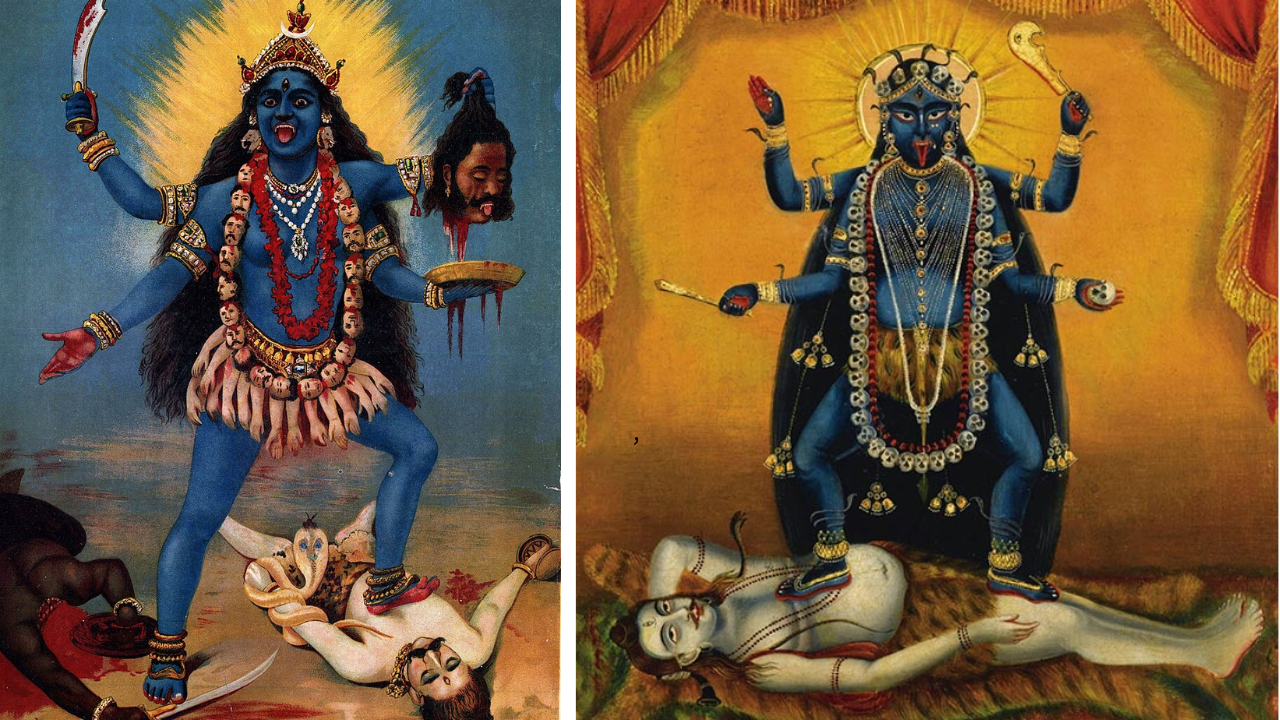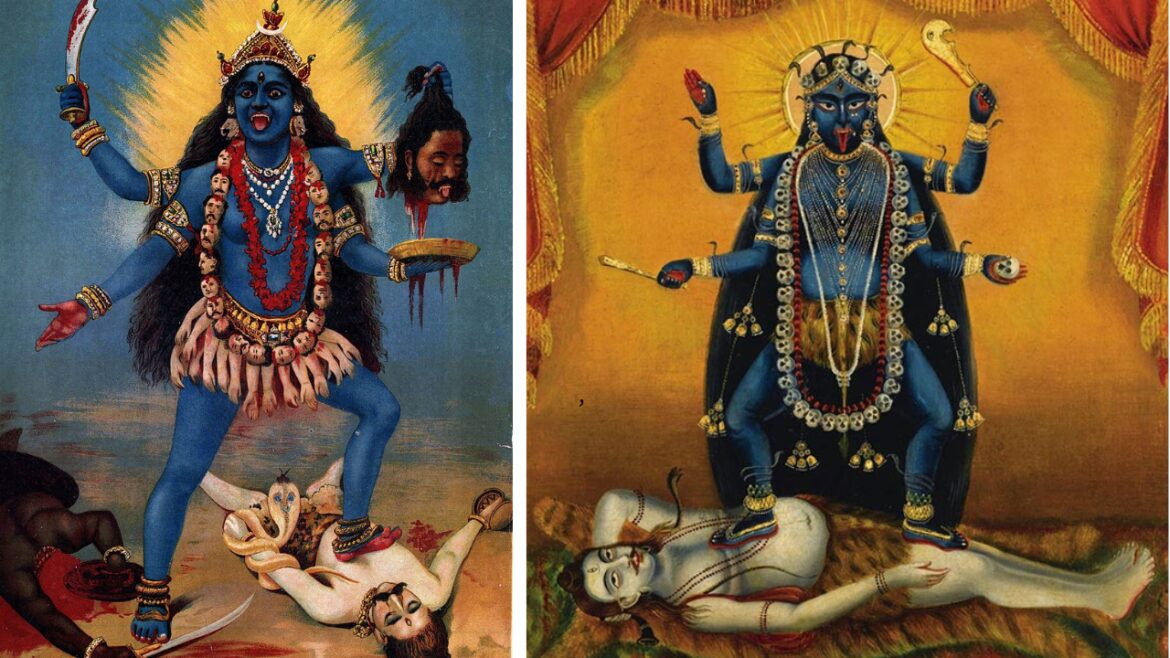
On the day of Diwali, when everyone worships the goddess Lakshmi and lord Ganesh, one community worships the goddess Kali. In the 16th century, a Bengali saint and a Tantric scholar Krishnananda Agamvagisha had a dream. In his dream goddess Kali instructed him to worship her in this form on the new moon day called Dipannita Amavasya of the Hindu month of Kartik.
While the Puja was started in the 17th century, however, it reached the masses and became a widespread yearly festival in the 19th century. This happened when Kali devotee Sri Ramakrishna Paramahangsha became a popular religious leader among the communities and influenced many Bengali landowners to patronise the goddess. This soon became the second major festival of the Bengali community after Durga Puja.
History Of Goddess Kali
Goddess Kali was widely worshipped as a tribal goddess before it was brought into the mainstream. The origin traces back to the pre-Vedic and Vedic eras in Ancient India. This is when Kali first appeared in the ten Mahavidyas, in Hindu tantric tradition. However, the major appearance of Kali happened, when Sanskrit literature on the goddess was written as a part of Devi Mahatmya.
Shakti and tantric sects also worshipped Kali as the ultimate reality and are seen as the divine protector and bestower of liberation.
While Kali appears in many stories, the most famous one is her story of defeating the demon Rektabija. The demon, as the name suggests, Rakta which means blood and bija which means seed, could reemerge after being killed if his blood fell on the ground. When Kali was at war with him, soon there were thousands of Raktabija on the battlefield. To end this, goddess Kali drank every drop of Rakbija’s blood before it touched the earth and wore his head like a garland. This eventually killed him.
The reason why Kali's tongue is out is because on the battlefield, she was out of control and her rage could destroy anger. This is when Shiva decided to do something about it and lay down under her food. The moment she stepped on Shiva's chest, she realised what had she done and as an act of regret and modesty in the Bengali tradition, her tongue was stuck out.
Also Read: Behind The Scenes Of Delhi’s Oldest Durga Puja
How Did Kali Puja Reach Delhi?
While it was famous in Bengal, it soon reached Delhi by the 19th century. One of the Kali devotees saint Sri Krishnananda Brahmchari, from Hoogly district, built a total of 32 Kalibaris in northern India, including Delhi, Punjab, Uttar Pradesh's Ayodhya, Central India, Baluchistan, and Himalayan hill provinces. He was responsible for establishing Delhi's first Kalibari in 1840 near Yamuna's Nigam Bodh Ghat.
However, the idol was destroyed during the 1857 Sepoy Mutiny. After the mutiny, one of Sri Krishnananda Brahmchari's disciples Sri Neelmani Brahchari repaired the broken idol from the banks of Yamuna and re-established the idol in a rented house in Roshan Pura. This was done with the support of the first allopathic doctor of Delhi, Dr Hemchandra Sen, the HC Sen Marg near Chandni Chowk is named after him.
Finally in 1917, with many more Bengalis coming to Delhi and forming a strong-knit Bengali community around Old Delhi and Kashmere Gate, Delhi's first Kalibari near Tis Hazari Maidan was established. The same idol was placed in a small hut that served as the temple, which is worshipped even today.
The same community that established the Kalibari was associated with Delhi's oldest Durga Puja in Kashmere Gate, which is celebrated today at the Bengali Sr Secondary School.
It was since then that every year on the night of Diwali, Kali Puja was also celebrated in Delhi. Even to this day, Delhi's Bengali community flock to Tis Hazari Kalibari. Over time, more Kalibaris came into existence.
In 1925, another Kali Bari was set up near Baird Road, or what we know today as the Bangla Sahib Road. However, it was shifted near the Birla Temple in 1931, also its present location.
The Shiv Temple of CR Park, Delhi's mini Kolkata came in much later in 1973. This happened because, after the Pakistan partition, many Bengalis from East Pakistan came and settled in CR Park, which was known as the East Pakistan Displaced Persons Colony. In 1984, a Kali temple was constructed in the same complex, and other additions such as the Radha-Krishna temple were also made with Bengal terracotta architecture. Artists from West Bengal designed the temple and their names are etched on the temple wall even today.
How Is It Celebrated?
Kali Puja is celebrated during the new moon period, which means it is celebrated at night. This year, Kali Puja will start at 11.25 pm and will last till 01.01 am. After the Puja is done, devotees are offered fruits, sweets and bhog, which includes khichdi, kheer, and fried vegetables. Earlier, religious sacrifices were also made, however, it no longer is in practice. Though, in some places, meat is also offered as part of the bhog during Kali Puja.
A 300-year-old Kalibari in West Bengal, known as the Thanthania Kalibari, established in 1803, as the building suggests, is one of the few places where religious sacrifices continue to happen.
Another form of worshipping Kali is through the tantric traditions that take place in the cremation ground. Kali is considered an incarnation of Shakti, a different version of Durga, and she is associated with Shiva, her husband. Shiva was known to be covered with ashes from the cremation ground, this is why Kali is also associated with the cremation ground and is known as Shamshan Kali (or the Shoshan Kali in Bangla). She is also considered the protector of the cremation ground. It is believed that worshipping the Shamshan Kali would help one get rid of black magic or witchcraft.

